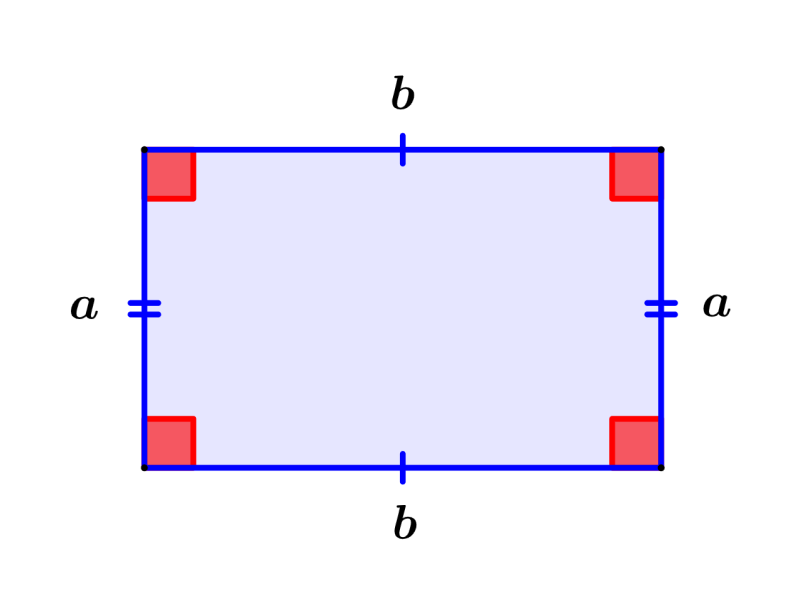A rectangle is a two-dimensional figure with four sides. A rectangle can also be considered as a four-sided polygon, in which opposite sides are parallel and equal to each other. The rectangle is one of the types of quadrilaterals, in which the four angles are right angles or equal to 90 degrees. The rectangle is a special type of parallelogram with all its angles equal. A rectangle with four equal sides is known as a square.
Here, we will look at the properties of rectangles along with some examples.
Fundamental properties of rectangles
The fundamental properties of rectangles are as follows:
- A rectangle is a quadrilateral.
- Each interior angle in the rectangle is equal to 90 degrees.
- The sum of all the interior angles of the rectangle equals 360 degrees.
- The opposite sides of a rectangle are parallel.
- The opposite angles of a rectangle are equal.
- The diagonals of the rectangle bisect each other.
- Both diagonals of the rectangle have the same length.
- A rectangle with sides of length a and b has a perimeter 2a + 2b.
- A rectangle with sides of length a and b has an area ab sin(90°) = ab.
- A diagonal of a rectangle is a diameter of its circumcircle.
- If a and b are the sides of a rectangle, then the length of each diagonal is $latex d = \sqrt{{{a}^2}+{{b}^2}}$.
- The diagonals bisect each other at different angles. One angle is acute and the other is obtuse.
- If the two diagonals bisect each other at right angles, the rectangle is a square.
- A cylinder is obtained when the rectangle is rotated with respect to the line joining the midpoint of the longest parallel sides. In that case, the height of the cylinder is equal to the height of the rectangle. Also, the diameter of the cylinder is equivalent to the base of the rectangle.
- A cylinder is obtained when the rectangle is rotated with respect to the line joining the midpoint of the shorter parallel sides. In that case, the height of the cylinder is equal to the base of the rectangle. Also, the diameter of the cylinder is equivalent to the height of the rectangle.
Examples of the properties of rectangles
EXAMPLE 1
A rectangle has sides of length 15 m and 12 m. Calculate its perimeter.
Solution: We know that the perimeter of a rectangle is equal to $latex 2a+2b$ or also equivalent to $latex 2(a+b)$. Therefore, using the given lengths, we have:
$latex p=2(a+b)$
$latex p=2(15+12)$
$latex p=2(27)$
$latex p=54$
The perimeter of the rectangle is equal to 54 m.
EXAMPLE 2
What is the area of a rectangle that has sides of length 8 m and 12 m?
Solution: The area of a rectangle can be calculated using the formula $latex A = ab$. Therefore, using the given values, we have:
$latex A=ab$
$latex A=(8)(12)$
$latex A=96$
The area of the rectangle is 96 m².
EXAMPLE 3
What is the diagonal of a rectangle that has sides of length 8 cm and 15 cm?
Solution: The diagonal of a rectangle is given by the formula $latex d= \sqrt{{{a}^2}+{{b}^2}}$. Therefore, we can substitute the values to get:
$latex d=\sqrt{{{a}^2}+{{b}^2}}$
$latex d=\sqrt{{{8}^2}+{{15}^2}}$
$latex d=\sqrt{64+225}$
$latex d=\sqrt{289}$
$latex d=17$
The diagonal measures 17 cm.
See also
Interested in learning more about rectangles? Take a look at these pages:




